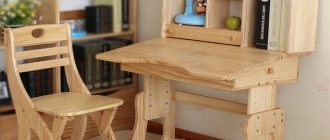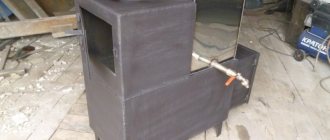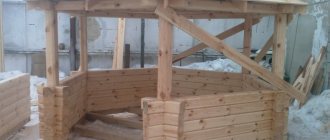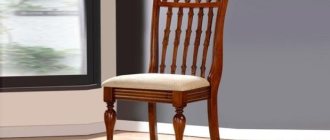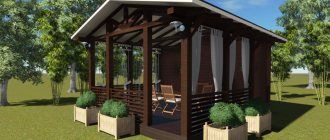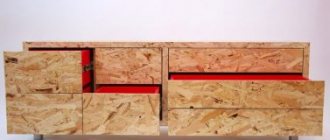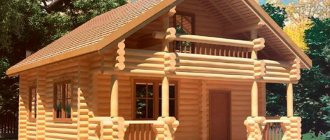When working with wood, one of the most popular tools is a circular saw. This device, characterized by productivity and convenience, can significantly speed up the process of sawing moldings or sheet materials. When carrying out work in significant volumes, it makes sense to think about making a special stationary structure with a saw, which will improve the safety, speed and quality of the work.
DIY table for a circular saw - drawings
Materials
When assembling a cutting table from chipboard with your own hands, you should maintain an optimal balance between functionality, safety, time and money. This can be achieved by selecting parts and materials with the necessary parameters. It is possible to reduce costs by using old parts of other structures - furniture, frames of wooden houses and outbuildings.
Tabletop
The main requirements for a saw table are resistance to heavy loads, shocks and vibration. The tabletop must be smooth enough to move and not bend under a weight of 50 kg or more. Suitable options might be:
- Metal (steel or duralumin) 3–5 mm thick. The advantages of metal countertops are high strength, almost unlimited service life, the disadvantages are heavy weight, decent cost.
- Laminated chipboard or moisture-resistant plywood with a thickness of at least 2 cm. The cost of this option will be the most profitable, but the strength is noticeably reduced.
- Textolite 15–20 mm thick. The material is more durable than plywood, but inferior to metal. In terms of cost, textolite countertops are also between metal and plywood sheets.
Plastic, chipboard or OSB are not recommended as countertop materials. A structure made from this raw material will be unstable to vibration from the saw. It is possible to make a table entirely from natural wood, but it is too expensive.
Metal
laminated chipboard
Textolite
bed
At the base of the table for sawing boards there can be wooden beams, secured under the lid to increase rigidity. Elements with a cross-section of at least 5 x 5 cm are placed at a distance of 50–90 mm from the edge of the tabletop. For the sawing table, it is recommended to choose bars made of hard wood - beech, hornbeam, oak. The advantages of wood are low cost, easy installation using self-tapping screws. Disadvantages - less strength and service life, high probability of fire.
The upper part of the table frame for cutting chipboard and other materials is often made by hand from the same sheets that were chosen for the table top. For the legs of a wooden structure, it is recommended to use timber, securing it with metal corners. The pros and cons of wooden supports are similar to the features of a frame made of the same material.
The basis of the table for cutting and sawing boards can be metal. Stability increases when choosing metal corners or channels with sides of 25–50 mm. To save money, they are purchased at scrap metal collection points or replaced with profile pipes. The frame parts are connected by welding. The use of bolted connections is not recommended due to the possibility of loosening due to vibration. The reasons for choosing a metal frame are maximum strength, reliability, and easy maintenance. Disadvantages: high cost, need to use a welding machine.
Metal
Wooden beams
Chipboard plywood
Making stops
The last stage of making a sawing table with your own hands is installing stops. A standard part of most circular saws is a rip guide. Traditionally, the stop is made from an aluminum cornice or a wooden block. Its size is chosen so that the part runs across the entire table - parallel to the saw and from edge to edge.
Cross stops are also often used on sawing tables. They are used to cut parts at an angle of 90 degrees and trim boards. To make a stop, follow these steps:
- Prepare an ordinary plywood sheet 1 cm thick.
- Secure a block at least 2 cm high to it.
- Attach a second rail perpendicular to the first on the bottom side of the base.
- Cut off excess base.
The transverse stops are attached to the workpieces using clamps or fastening devices made from wooden washers. Such homemade clamps provide fastening of guides to parts of almost any width. If you fix the block on the underside of the base at an angle of 45 degrees, you get a corner stop. After all work is completed, the surface of the circular table can be treated with a grinding machine and coated with a layer of protective varnish. This will protect it from various mechanical damage, and in general will extend its service life.
Perhaps such a table does not look as attractive in appearance as a factory one. However, from a technical point of view, it is in no way inferior to it, so even a novice carpenter can safely take on its manufacture.
Prepare parts for the longitudinal stop
Assemble mounting brackets
Place the bar on the table
Clamp the crosscut pieces together
Attach the cross supports using clamps
Cross stop is ready
Features of a circular saw
Knowledge of these features is extremely important; you must take into account the operating modes of the saw, know the type of loads and take all possible measures to strengthen the most important components. Only with this approach can long-term and safe operation of a homemade machine be achieved.
What are the common features of woodworking machinery?
High speed saw teeth. This ensures the quality of sawing. But high speeds of the saw blade cause serious injuries; during the manufacture of the machine, great attention must be paid to safety precautions. All devices available on industrial copies must be installed without fail. Do not think that some of them are superfluous, and you will be able to modernize factory samples for the better. All safety rules are written in the blood of injured people, do not repeat tragic mistakes.
Strength of all nodes
This means the inability to withstand significant static loads, although this is very important. The table can easily absorb large forces of this type, but at the same time vibrate under the influence of even relatively minor dynamic multidirectional loads. This condition does not have a negative impact on safety, but noticeably deteriorates the quality of the cut.
Marks of teeth are noticeable on the surface of lumber, it is difficult to maintain specified linear dimensions, etc.
Fire and electrical safety. Absolutely all electrical devices, motors, starters and other special fittings must be installed in strict accordance with the requirements of the PUE. You need to know that dry sawdust not only burns well, but also forms an explosive mixture at a certain concentration in the air. By the way, burning sawdust is difficult to extinguish; it floats on the water and continues to burn.
There is no need to make the simplest machine at the expense of safety devices; strictly follow the recommendations of the designers. Decide what you need, a woodworking machine or fresh problems?
Blueprints
Diagram for making a table for a circular saw
Before starting work, it is recommended to go through the preparatory stage. You should definitely make a drawing. This will make the design creation process easier. First, calculate the dimensions of the table, then transfer the data obtained to paper. The hole made in the structure must exactly match the dimensions of the saw. It all depends on the brand of equipment. Therefore, it is impossible to make a universal hole. The base must be stable and withstand mechanical loads well.
DIY table drawing for a circular table
It is unacceptable to overhang the structure to one side. The dimensions of the tabletop must be suitable for the sawing flow. The final option is determined based on individual desires. Some people work comfortably with a folding table or a product with small dimensions.
Drawing of a universal tabletop machine
An important point should be taken into account in the drawings. If you plan to leave tools or materials on the table while working, then the dimensions of the tabletop need to be increased to a square meter in area. A suitable size would be 120 by 120 cm. You should draw the drawing carefully and slowly in order to do everything correctly.
Table diagram for a circular table with a detailed description
Adviсe
- Before you start using an electric saw on a table, you should check the blade of the saw itself using a square, since some unscrupulous manufacturers do not install the blade exactly at an angle of 90 degrees, as a result of which the cuts end up beveled.
- If during work you plan to use the table also to store tools on it, then the dimensions of the tabletop should be larger than a square meter in area.
- For manufacturing it is better to use high-quality and durable materials, otherwise the table will not last long.
- The table can be supplemented with anything you like, for example, some manage to attach a special vacuum cleaner or a riving knife with protection for the disk to it, so that shavings and residues from cutting wood do not fly to the sides.
- Select a place to install the table in advance, and also make sure that the floor where the table will be installed is level.
- If you have the desire and certain skills, you can make a folding tabletop or a lifting table, but this will require more time and materials.
- If the table wobbles or vibrates during operation, adjust the height of the legs using suitable pieces of rubber.
Manufacturing stages
Before assembling the machine for cutting boards, logs and blanks, you should prepare all the necessary materials and tools. To work you will need:
- moisture-resistant plywood;
- sheet material suitable for making the body;
- elements for the body and legs (bars 40 by 40 mm).
Fastening will be done with self-tapping screws using a screwdriver. All necessary parts are cut with a jigsaw. A saw with a disk of suitable diameter is also prepared.
Algorithm for creating a table:
- Sawing all parts into pieces with the required dimensions.
- Marking the mounting areas for the saw and legs on the table top.
- Making a case, which is usually a rectangular box without a lid or bottom.
- Installation of countertops.
- Cutting a hole that should be 5–10 mm longer and 4–6 mm wider than the disc.
If you cut the material at a certain angle, the resulting slot should resemble a trapezoid (inverted) in shape. For smooth sawing, a regular hole is made. Before cutting out the groove, you should apply a saw and adjust the marks.
Sawing all parts into pieces with the required dimensions
Marking the mounting areas for the saw and legs on the tabletop
Case manufacturing
Installing the countertop and cutting the hole
Preparing to install the saw
Table saw
When choosing a circular saw, you need to be guided by the following characteristics:
- Saw power. If the amount of work is quite large, it is advisable to take a tool with a power of at least 1.2 kW.
- Cutting depth. The thickness of the material to be processed depends on this parameter. For hand saws it is 40–70 mm. But when installing it in a table there will be a decrease of around 10 mm.
- Button placement. The design of the sawing table must provide free and safe access to all control buttons, otherwise it will be necessary to modify the control system yourself.
- Rotational speed. For cutting wood, high rotation speed is preferred. This affects the cutting quality. For plastic, for example, this is not very good. Due to the high rotation speed of the circle, the plastic heats up. You need to choose average characteristics. 3-4 thousand rpm will be enough.
The benefits of making it yourself
The table is made taking into account the fact that the hand tool will be installed and secured on the table, thereby turning into stationary equipment
Constructing the element with your own hands allows you to make the saw most suitable for individual conditions. There will be no difficulties in the process if you carefully study the issue. You can adjust the product to the desired size, distribute everything so that it is convenient for you.
Making a table for a circular saw is within the capabilities of every craftsman.
A handcrafted model will be one of a kind, which makes it unique.
Small table stand for circular saw
Selection of dimensions
It is worth choosing the size of the sawing table depending on the square footage of the workshop. The small area of the room allows you to use a tabletop of 50 x 50 cm. Making the sawing table smaller does not make sense - it will be difficult to use it when processing long workpieces. The universal size, ensuring convenient sawing of laminated chipboards, is 80 x 80 cm.
To comply with safety requirements, it is recommended to place the saw in the middle of the tabletop at a distance of at least 25 cm from the edge - it is this indicator that leads to the minimum width of 500 mm. The location of the saw blade also depends on how it will be used. There are three types of design:
- for longitudinal sawing;
- for cross cutting;
- universal.
The depth and location of the disk installation depend on the workpieces processed on the machine. For boards and plywood, it should protrude above the tabletop by 50-80 mm, for logs - by 110-125 mm. The height of the upper part of the frame made of sheets of plywood or chipboard can be in the range of 35–40 cm. If you make the frame only from timber, this parameter depends on the cross-section. The remaining part of the structure consists of wooden legs, the size of which craftsmen usually choose to suit their height. The overall height of the sawing table is about 1.0–1.1 m, but can be reduced to 900 mm.
Desktop device
The design of a table for a manual circular saw is so elementary that most specialists produce it without preparatory drawings and techniques. This is a dense workbench that is created from wood and plywood.
The most durable table bases are made from alloy. They are the heaviest and require the presence of welding skills. Therefore, stands are often made from leftover lumber. A circular saw is attached under the tabletop, and the drive protrudes above it through a specially made slot. The lumber is advanced along the table top and sawn with a disk. For convenience and correct operation, the table is equipped with additional devices: an angular and longitudinal stop.
The tabletop “absorbs” part of the working plane of the disk; the depth of cut will decrease by the thickness of the tabletop. For this reason, it is preferable to choose a circular saw with the largest disk diameter, and a table cover that is thin but rigid.
If you have not purchased an electric saw yet, choose modifications with high power (from 1200 W). They can handle cutting large-sized wood. Holes will be drilled to secure the base. The solid base may burst. For this reason, it is advisable to select a mechanism of a different type.
Safety requirements
One of the most common causes of injuries when using a circular saw is a cluttered workplace.
In addition, it is important to monitor the stability and strength of absolutely all components of the system, and if there is imbalance, take measures to eliminate difficulties. Before connecting the saw, you must make sure that it is well secured. If necessary, tighten the screws/bolts. It is strictly forbidden to hold the material close to the cutting site! This is dangerous due to the rebound of knots and shavings into the eyes or onto open parts of the body.
Be sure to wear glasses before work and clothes with sleeves.
Making your own saw table is not as difficult a task as it might seem. If you have good material at hand, its characteristics are chosen correctly, and the power of the device ranges from 500 to 1000 W, the above instructions will be the basis of the work.
You should not lose sight of the fact that at any stage of table production you should control the accuracy of your own operations. Otherwise, if deviations in size or deformation of the legs appear when the ribs are tightened, it will be very difficult to restore stability. Nevertheless, making a table for a circular table with your own hands is an absolutely realistic task that will take several hours.
Table production process
- You need to cut a tabletop of the required size from a sheet of plywood. Markings are applied to the lower area using a metal ruler and pencil. Cut the plywood with a jigsaw, milling the edges if necessary. If the plywood is not laminated, we clean the surface of the table with sandpaper.
- They shift it and make markings from the bottom for attaching a manual circular saw. To do this, remove the disk from the device and place it with the sole in the required place. We make marks on the table top and at the base for fasteners and a hole for the saw blade. Drill holes for the bolts. They will be twisted from above under the tabletop and held in place with nuts at the bottom. Therefore, the holes are countersinked from the edge of the working plane, and the bolt heads are leveled so that they do not protrude.
- If it is planned to cut the material at different angles, the slot for the saw-tooth circle is made in the shape of an inverted trapezoid. For straight sawing, an ordinary groove is made. Before marking the slot and holes for fasteners, you need to apply a saw, adjust the marks and only then cut.
- Draw with a pencil the areas where the stiffening ribs are located. They are made from boards and installed below 8-9 cm from the edge of the tabletop itself. The table legs must be fixed to the ribs. The ribs are secured with self-tapping screws at intervals of 15–25 cm, and in addition they are glued with PVA. Self-tapping screws are screwed on top, under the tabletop, the heads are completely recessed. The ribs are fastened together with self-tapping screws.
- The legs are made of timber or boards, their length will be from 100 to 113 cm. The legs diverging downwards will give significant stability. They are fixed with large bolts twisted on the outside and reinforced with nuts on the inside. Timber ties will strengthen the frame.
- In order to adjust the height of the table, nuts are attached at the bottom into which M14 bolts are screwed. Now you can secure the saw from below by passing the drive into the prepared slot.
- We attach an electrical outlet to the table, run an electrical cable from it and set the switch. Power to the outlet will be transferred from the switch. We stretch the cable from it to the nearest source in the workshop. With the support of the construction screed, we fix the ON-OFF key on the body of the circular saw in a recessed state.
- Let's start producing auxiliary stops. For the stop you will need a number 30 square cut aluminum pipe and 2 screws with wing nuts. We saw off a piece of pipe along the length of the tabletop, making holes for screws 3 cm from the edge. 2 clamps are cut out from pieces of plywood. The system is ready.
- To process across the table, we use a plywood sled. We align them with the edges of the table, press them down and move them along the toothed circle. We cut a hole in the passage area of the circle. Small components can be placed directly inside the slide and sawed. Dust will be removed from under the table, but a significant part of it will still fly upward, so it is good to supplement the device with an upper dust extractor.
Working with a circular saw is very dangerous , for this reason it is necessary to take care of protecting your fingers. Cut a pusher from a piece of wood or furniture board.
Additions to the completed design
Some craftsmen, when assembling a table for a hand-held circular saw according to unique drawings, completely remove the factory safety cover and replace the factory platform with a homemade one. If cutting at an angle is not planned, you can remove all devices for adjusting the tilt of the disk. The electric saw is fixed directly to the new base, which makes it possible to gain a couple of millimeters of cutting depth.
Without an internal casing , it is easier to remove the blade; the electric saw will not become clogged with shavings when working with wet boards. Dismantling will require extra time, but the service life of the motor is preserved and overload is prevented.
Mounting a circular saw
The matter remains small. The circular electric saw is located inside the prepared hole. The sole is secured with bolts , and the gear drive must fit freely into the socket.
The table for the circular saw is almost ready. Now it needs to be treated with a moisture-protecting material, then coated with varnish in several layers (to minimize slipping).
The resulting system can be supplemented with anything at the user’s discretion (safety cover, device for adjusting the tilt of the disk, carriage, etc.).
Additional accessories for convenient work
On the tabletop parallel to the disk, lines are drawn every 10 cm to help cut the wood to size. Markers alone are not enough; you will need a longitudinal stop. It is convenient to use a profile pipe for its manufacture. It should move freely on the tabletop to install the required size and be fixed in the desired position.
One of the design options: transverse grooves 10 mm wide need to be made in the surface of the structure. In the thrust strip, 2 holes are drilled along the edges for M10 bolts. They fix the stop, threading the tabletops and planks through the body. This method weakens the product a little.
Use another option. The stop is cut 20 cm longer than the length of the table. On each side, 10 cm of timber is glued, the thickness of which is equal to the base of the structure. Iron plates of 3–5 mm are fixed to them with self-tapping screws. It turns out to be a bracket that clings to the table. Drill holes and weld an M8 nut. Screw in the bolts, preferably with wings. They fix the stop in the desired position.
For convenient cross-cutting, a sled is made. The structure is pressed against the table and moves along the disk.
Expansion of functionality
In conclusion, let’s touch on the topic of expanding the functionality of the working structure you are making. If there is free space on the operating surface, additional woodworking equipment (an electric plane or router, for example) can be mounted. Having a plane and a wood router will allow you to expand the functionality of the machine and turn it into a full-fledged woodworking center.
In addition to this, such a milling cutter can be equipped with a special mechanism for adjusting the position of its working part, which can be changed within specified limits (the so-called elevator).
